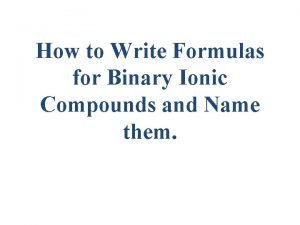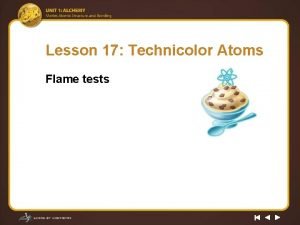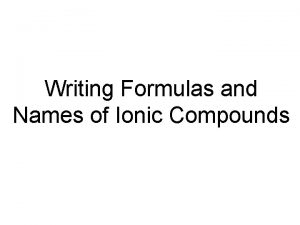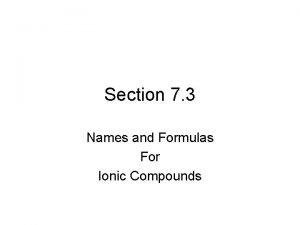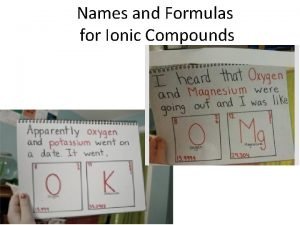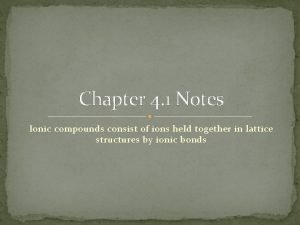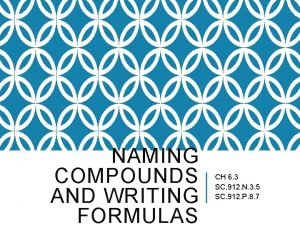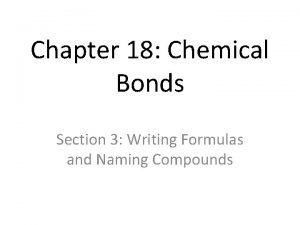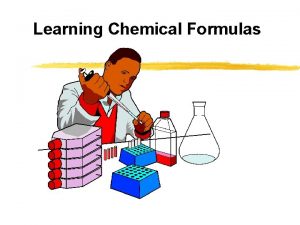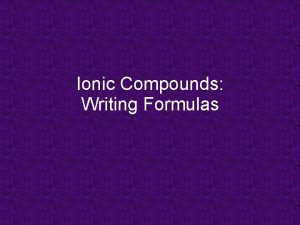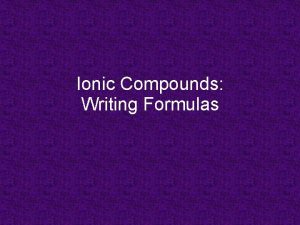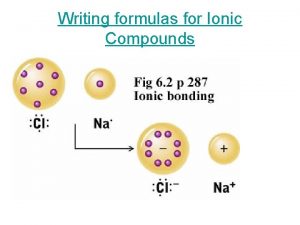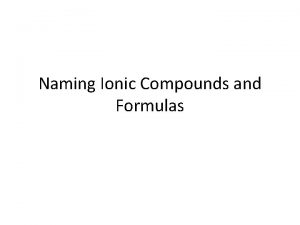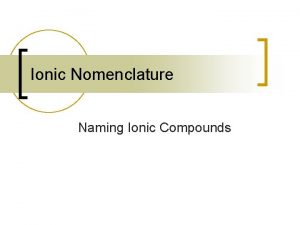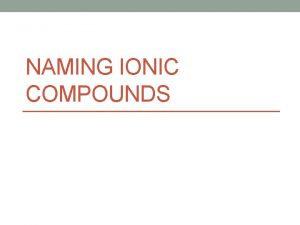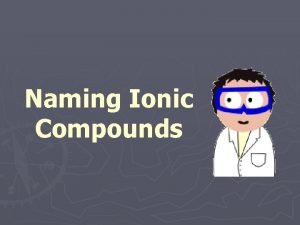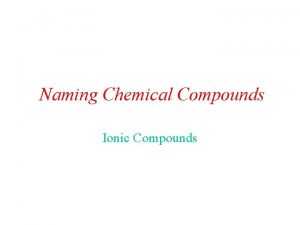Facts for Ionic Formulas Simple Ionic Compounds Concept












- Slides: 12

Facts for Ionic Formulas

Simple Ionic Compounds Concept: Ionic Formulas are formed from positive and negative ions. Fact 1: Positive ions are formed by metals that lost electrons. These are cations. Examples: Na 1+ Mg 2+ A 3+ P 4+ Ca+ion n io Fact 2: Negative ions are formed by eg N a ati ve nonmetals that gained electrons. These are anions. Examples: Cl 1 - O 2 - N 3 - Si 4 -

Simple Ionic Compounds +3 Gain 2 e. Gain 1 e- Gain 3 e- +1 +2 Lose 3 e- Lose 2 e- Lose 1 e- z. Fact 3: We can predict the charges of the main group elements based on where they are on their families. -3 -2 -1 0

Simple Ionic Compounds Fact 4: The overall charge of ionic compounds must equal zero. Examples : Na 1+ Cl 1 - Ca 2+Br 1 Al 3+O 2 -

Lesson Two--Polyatomic Ion Formulas Concept: Polyatomic ions are groups of atoms that behave as one unit. Fact 5: Some ions have more that one atom. You will need to memorize most of these but some you can figure out from their atoms. Examples: (SO 4) = S +6 and O -8 = -2 (NO 3)= N +5 and O -6 = -1 (NH 4) = N -3 and H +4 = +1

Polyatomic Ion Formulas Fact 6: These group ions, polyatomic ions, are treated like single ions in formulas, but must have parentheses when more than one is used in a formula. Examples: Ca 2+ and (NO 3) 1 - = Ca(NO 3)2 Ga 3+ and (SO 4) 2 - = Ga 2(SO 4)3 (NH 4) 1+ and O 2 - = (NH 4)2 O (NH 4) 1+ and Cl 1 - = NH 4 Cl

Polyatomic Ion Formulas Fact 7: The polyatomic ions are named based on the atoms that they contain. Those with oxygen and another nonmetal are often name "____ate" with the root of the other nonmetal in the blank. Examples: (NO 3)1 - is nitrate (SO 4)2 - is sulfate (Cl. O 3) 1 - is chlorate

Polyatomic Ion Formulas Fact 8: Those polyatomic ions with one oxygen less than the "ate" ions are named "----ite" ions. Examples: (NO 2)1 - is nitrite (SO 3)2 - is sulfite (Cl. O 2)1 - is chlorite

Lesson Three--Transition Metal Compounds Concept: Transition metals have electrons in d orbitals and can donate different numbers of electrons, thus giving them several different positive charges. Fact 9: These can be determined from the Roman numeral which is written next to the metal's name. Example: Cu 1+is Copper I Pb 2+is Lead II Fe 3+is Iron III Sn 4+s Tin IV

Transition Metal Compounds Fact 10: These transition metals are used in formulas just like other metals, once the charge is determined from the Roman numeral in the name. Example: Cu 1+ Cl 1 - = Cu. Cl Pb 2+O 2 - = Pb. O Fe 3+Br 1 - = Fe. Br 3 Sn 4+O 2 - = Sn. O 2

Transition Metal Compounds Fact 11: A few transition metal ions only have one charge and never change so they can be written without a Roman numeral in their formula name. Example: Ag 1+ Zn 2+ Cd 2+

Lesson Four--Using Formulas in Problem Solving Concept: Correctly written chemical formulas hold a large amount of information for the prepared student to find. Fact 12: The subscripts tell us the number of atoms of each kind that is present in the compound. Example: Na. Cl has one atom of sodium and one atom of chlorine. H 2 SO 4 has two atoms of hydrogen, one atom of sulfur and four atoms of oxygen
 Ionic, covalent and metallic bonds venn diagram
Ionic, covalent and metallic bonds venn diagram Naming hydrates
Naming hydrates Writing binary formulas
Writing binary formulas Lesson 17 technicolor atoms flame test answers
Lesson 17 technicolor atoms flame test answers Monoatomic ion
Monoatomic ion Writing formulas for ionic compounds worksheet
Writing formulas for ionic compounds worksheet Section 3 names and formulas for ionic compounds
Section 3 names and formulas for ionic compounds Section 3 names and formulas for ionic compounds
Section 3 names and formulas for ionic compounds Concept 2 notes naming ionic compounds
Concept 2 notes naming ionic compounds Naming and writing formulas for molecular compounds
Naming and writing formulas for molecular compounds Which two formulas represent compounds
Which two formulas represent compounds Empirical formula pogil
Empirical formula pogil Section 3 writing formulas and naming compounds
Section 3 writing formulas and naming compounds


